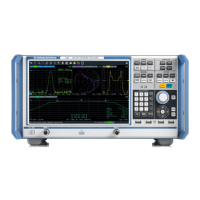Concepts and Features
R&S
®
ZNB/ZNBT
99User Manual 1173.9163.02 ─ 53
Marker Format Description Formula
Lin Mag Phase Magnitude of z (unconverted) and phase in two
lines
|z| arctan ( Im(z) / Re(z) )
Real Imag Real and imaginary part of z in two lines x y
R + j X
or
R + j X series
***)
(Series) impedance:
Unnormalized (series) resistance, reactance, and
either inductance or capacitance, in three lines
(Smith diagram)
R
s
X
s
L
s
or C
s
**)
R + j X parallel
***)
Parallel impedance:
Unnormalized parallel resistance, reactance, and
either inductance or capacitance, in three lines
(Smith diagram)
R
p
X
p
L
p
or C
p
**)
G + j B
or
G + j B series
***)
(Series) admittance:
Unnormalized (series) conductance, susceptance,
and either inductance or capacitance, in three
lines (Inverted Smith diagram)
G
s
B
s
L
s
or C
s
**)
G + j B parallel
***)
Parallel admittance:
Unnormalized parallel conductance, susceptance,
and either inductance or capacitance in three lines
(Inverted Smith diagram)
G
p
B
p
L
p
or C
p
**)
Imp Mag
or
IMP Mag series***)
Magnitude of (series) impedance
**)
|Z
s
| = (R
s
2
+ X
s
2
)
1/2
Imp Mag paral-
lel***)
Magnitude of parallel impedance
**)
|Z
p
| = (R
p
2
+ X
p
2
)
1/2
Adm Mag
or
Adm Mag series***)
Magnitude of (series) admittance
**)
|Y
s
| = (G
s
2
+ B
s
2
)
1/2
Adm Mag paral-
lel***)
Magnitude of parallel admittance
**)
|Y
p
| = (G
p
2
+ B
p
2
)
1/2
Index Index of the current sweep point –
*)
The delay aperture is defined in the [TRACE CONFIG] > "Format" softtool.
**)
An impedance Z is represented as Z = R + jX, the corresponding admittance as Y =
1/Z = G + jB. For X ≥ 0, we have an inductance L = X/ω, for X < 0 we have a capaci-
tance C = 1/(ωX), where ω denotes the stimulus frequency.
***)
Only avaiilable for transmission measurements (see Chapter 5.3.3.1, "Converted
Impedances", on page 120)
Marker Coupling
It connects the markers of a set of traces.
Marker coupling allows you to compare different measurement results (assigned to dif-
ferent traces) at the same stimulus value. It connects the markers of a set of traces.
Screen Elements

